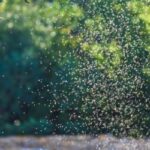
The long Kansas summers bring out some of our fondest memories: family barbeques, block parties, backyard games, and a chance to thrive in the sunlight. Unfortunately, we’re not the only ones who thrive in the warmer weather. Stinging insects like wasps and hornets are finally out to party and they’re going to make it your problem.
Many of these stinging insects like wasps and yellow jackets are drawn to the smell of sugary and protein-rich foods, be it what you have on the table or in your garbage can. With the warm weather carrying that smell far and wide, they’re prone to swarming to new locations in the summer, usually close to home.
How to Identify Common Stinging Insects:
Paper Wasps: Roughly ¾ to 1 ¼ of an inch in length, paper wasps have a darker amber carapace with black stripes along the back with a yellow ring. They’re moderately aggressive and build umbrella-shaped nests on twigs, porches, and branches.
Mud Daubers: 1 inch in length with a long, narrow, segmented body. Black and yellow in coloration with their rear segment having a distinctive bulbous shape. Despite looking scary they’re far more docile than their relatives. Their nests are short tubes of mud usually placed alongside each other.
Yellow Jackets: ½ to 1 inch long, yellow jackets have a black segmented body with bright yellow stripes running along its body. Their nests are made from chewed plant fibers and wood giving them a papery texture. Yellow jackets are the most aggressive of the three listed here, especially at the end of summer, and are famous for nesting in the ground and in attics or roofs.
Wasp and Yellow Jacket Control
Both wasps and paper wasps are more likely to swarm and find new areas to colonize, and getting rid of them can be a real pain. A few things to do that can prevent stinging insects from making a new home in your yard:
- The Plants In Your Garden: A great first step in wasp and yellow jacket prevention is choosing the plants in your garden well. Plants with strong smells like mint, citronella, and lemongrass can deter them. Staying away from nectar-producing plants will further these efforts.
- Wasp Traps: Available online or in stores for a great price or easy to build yourself they’re a wonderful part of stinging insect prevention. To build one yourself, cut a bottle in half, fill the bottom with a sugary fluid, and then use the top as a funnel. Wasps and hornets will be drawn in and drown in the fluid with very little effort spent on your part.
- Decoy Nests: This tip is specifically for wasp prevention but is highly effective. Hanging a fake nest under your porch or in a covered area where the rain can’t ruin it. Wasps won’t bother to inhabit a spot that’s already been taken by another swarm, so you’ll get to enjoy your time outside free from stinging insects.
- Professional Services: The risks that stinging insect stings pose can range from painful to deadly for those allergic to their venom. These insects can become aggressive when their homes are at risk; it is important to work with an experienced technician with wasp control and removal.
Wasp Control and Removal in Kansas
When trying to prevent or deal with these pests it can be time-consuming. American Pest Management is ready to help. With our PestFree365+ service not only do we help with wasp and yellow jacket removal and prevention but over 36 other common pests. Kansas residents can contact us today for a free quote to start living life pest-free; not only in the summer but for the rest of the year.




